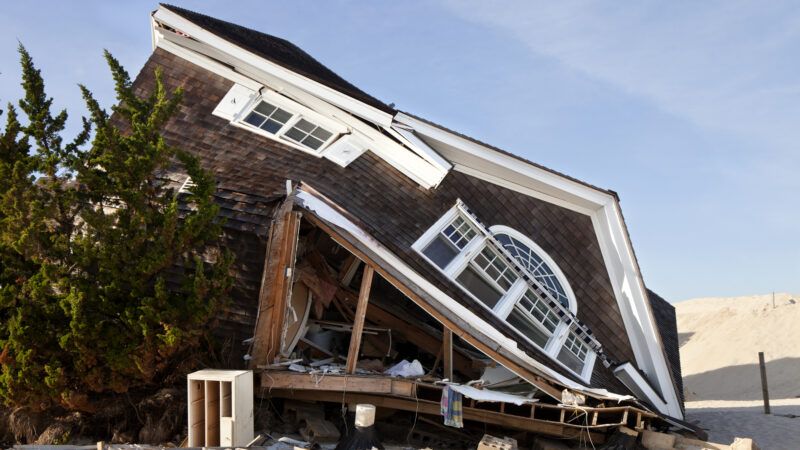Subsidized Flood Insurance Makes Storm Damage Worse
It's high time for Congress to end a program that routinely goes into debt providing subsidies to wealthy people living in high-risk areas.

Hurricane Idalia made landfall this morning along Florida's Gulf Coast as a Category 3 storm. It's expected to make its way up the East Coast as far north as North Carolina.
While the damage and potential losses will be tragic, it's also worth noting the federal policies that end up exacerbating these hurricanes' damage.
The National Flood Insurance Program (NFIP), managed by the Federal Emergency Management Agency, was created in 1968 to help homeowners in flood-prone areas afford insurance. Federal law requires that mortgaged properties in designated flood hazard areas carry flood insurance, but insurance premiums in oft-flooded areas are significantly more expensive (if they're even offered at all). The NFIP offers federal backing for policies that private insurers would not otherwise touch or that would be too expensive for most people to afford.
Today, the NFIP covers over 5 million policy holders and provides nearly $1.3 trillion in coverage. The program is nominally funded through insurance premiums, and if necessary it can borrow money from the Treasury to be paid back with interest.
But providing insurance to an otherwise uninsurable market comes at a price: A 2011 report by the nonpartisan Government Accountability Office (GAO) found that 22 percent of NFIP's policies were issued at subsidized rates, about 40–45 percent of the cost of an unsubsidized policy. Between 2002 and 2013, the NFIP collected between $11 billion and $17 billion fewer in premiums than the market would have dictated.
As a result of charging premiums below market rate, the NFIP often runs over budget: In 2017, the program owed more than $30.4 billion to the Treasury, the maximum amount it's allowed to borrow. In order to cover payments for damage caused by Hurricanes Harvey, Irma, and Maria that year, Congress canceled $16 billion of the NFIP's debt. (The NFIP has made no further payments since then and currently owes more than $20.5 billion.)
The policies themselves don't make financial sense. NFIP policy holders are not limited in how many claims they can file or how much money they can receive. As a result, more than 150,000 properties nationwide have flooded multiple times and received NFIP reimbursement each time. According to statistics compiled by Pew, these so-called "repetitive loss properties" account for just 1 percent of NFIP policies but 25-30 percent of payouts. By 2009, about 10 percent of repetitive loss policies had received payouts worth more than the properties themselves.
An insurance company's refusal to provide coverage in a high-risk area provides a disincentive to anyone who chooses to live there: When the inevitable happens, you'll be responsible for the damage yourself.
But when the government assumes the risk on an insurer's behalf and makes insurance cheaper than the market would dictate, it creates incentives for people to live in dangerous areas more likely to be battered by extreme weather events.
There is evidence that NFIP's artificially cheaper policies have done exactly that. A 2018 study by Abigail Peralta of Louisiana State University and Jonathan Scott of the University of California, Berkeley, found that after a county joins NFIP, its relative population "increases by 4 to 5 percent" as residents stay in high-risk areas as opposed to moving away.
But for subsidized insurance policies, market forces would be driving people away from living in dangerous areas.
NFIP policies are also more likely to benefit wealthier people with more expensive properties. A 2007 Congressional Budget Office paper found that the median value of an NFIP property was as much as 2.5 times higher than the national average; it also found that 23 percent were not the owner's primary residence. Nearly 80 percent of NFIP policies are located in counties that rank in the top 20 percent of income. And a 2016 study in the Stanford Law Review found that "people who live in wealthier zip codes, receive larger subsidies, both in absolute magnitude and as a percent of their premium."
Two decades ago, John Stossel relayed the story of his beach house in the Hamptons, built on the edge of the water and insured for just a few hundred dollars a year through NFIP. It was fully or partially rebuilt multiple times over the years before finally getting washed away in a storm, with taxpayers footing the bill each time.
As the 2023 hurricane season gets underway, it's high time for Congress to end the NFIP—a program that goes billions of dollars into debt providing subsidies to keep mostly wealthy people living in high-risk areas.



Show Comments (21)